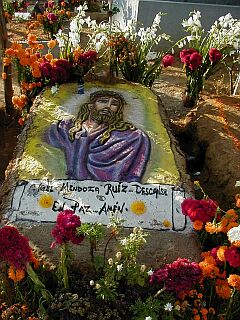
|

|
This is one plot in the vast "new" cemetary in Xoxocotlán (ho-ho-coat-LAN), a suburb of Oaxaca city. This picture shows a little bit of the decoration and devotion that Oaxaqueños lavish on the graves of their departed. When the sun sets, the families will gather in this graveyard, and many will remain until 5:00 a.m. when the holiday officially ends, talking, drinking and keeping company with their dead. [Photo by Diana Ricci]
|
Guided by the smoke from copál incense, burning amidst the gold and magenta flowers, the children arrive a day before their older departed. By arriving early, they are assured the choicest morsels, and an easy place at the table.
Child mortality rates are higher in third world countries, and the child-spirits will have lots of company in spite of serious efforts to reduce the rate of infant death. Government and nongovernment agencies work aggressively and tirelessly to eradicate the causes: inadequate prenatal diet, septic birth circumstances, lack of breast feeding (bad water and subsequent diarrhea are big killers), and failure to vaccinate against childhood diseases such as diphtheria and smallpox. By all reports, these efforts are succeeding, poco a poco (little by little). Even so, it is not unusual to see a funeral procession winding its way through downtown Oaxaca, carrying a three-foot coffin.
For us gringos, who are observers of, rather than bound up by, the traditions and celebrations of the Mexicans among whom we live, Los Dias offer an opportunity to admire other people's altars and grave decorations; to eat special foods like candy skulls and pan de yema (a glazed egg bread); to join parading masquers and musicians walking the streets and drinking mezcal.
There are organized cemetery tours for the less adventurous, along with classes on how to make mole (MO-lay, a paste used in sauces) and chocolate. Certain graveyards are "favorites" for tours, and the most crowded and well known are the cemeteries of Xoxocotlan. We have always avoided Xoxo for that reason, preferring to visit the smaller and less well known places.
When we journeyed to Xoxo in the early afternoon of November 1, it was to observe the annual building of the sand paintings in a local church. We had no intention of going to the cemetery, but we got misdirected and we ended up at one. We were with two friends (it was their car) who thought that as long as we were there, we might as well go in, and so we did.
Shortly after entering, our friends wandered off in one direction, and we in another, where we eventually encountered two young men holding beer bottles, and obviously intoxicated. The first, in slurred Spanish, kept calling me "Jefe" (chief), a distancing form of address to say the least (think of "amigo" as a way of including someone and you'll see what I mean). The second, picking up on my discomfort, started reassuring me that they really weren't so bad, and asked us to accompany him to a distant corner of the cemetery. There, next to a large marble mausoleum, was a small heap of dirt and a wooden cross with a plaque attached. "Cristina, 5 Julio 1997 - 12 Julio 1997". "Mi hija" (my daughter), he said, a kind of wistful sadness in his voice. I asked him what she died of. "Ask Him, He knows", he replied, pointing at the sky and shrugging his shoulders. I asked him if he had other children, and was told that there is a son, about 5 years old, very healthy. "She is an angel now, she had no time to sin" he said. "I don't know if angels can return (on November 1), do you?" I didn't, but suggested that maybe the priest would know. "Yes", he said, "That's a good idea. Perhaps I will ask him".
He walked with us to the entrance of the cemetery, where we joined our friends. We shook hands solemnly, smiled at one another, and parted, us to get back in the car to continue our search; he to enter the grocery store across the street to get another beer and -- who can say? - to continue his.
(November, 1998)